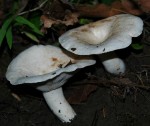 The pepper milk cap mushroom may be found singly or in large groups from summer to fall usually in deciduous woodlands, less frequently in coniferous ones, in the northern temperate zone including eastern and central US where it forms a close association with beech and hazel. The mushroom is 3.5 to 6 inches tall with a cap 2.5 to 4.5 inches across. The cap is white, firm, tough, and forms a funnel shape with age. It has an inrolled margin and is dry, often splitting in dry weather. The gills are thin, crowded, forked, and white before turning yellow with age. The cylindrical stem is ¼ to 1 ½ inches across and smooth. The spores are white. When the flesh is broken it exudes a white liquid that has a peppery flavor and is the basis of both the common and botanical names. The generic name, Lactifluus, comes from the Latin words lac meaning milk, and fluo meaning flo. The specific epithet, piperatus, comes from the Latin word meaning pepper.
The pepper milk cap mushroom may be found singly or in large groups from summer to fall usually in deciduous woodlands, less frequently in coniferous ones, in the northern temperate zone including eastern and central US where it forms a close association with beech and hazel. The mushroom is 3.5 to 6 inches tall with a cap 2.5 to 4.5 inches across. The cap is white, firm, tough, and forms a funnel shape with age. It has an inrolled margin and is dry, often splitting in dry weather. The gills are thin, crowded, forked, and white before turning yellow with age. The cylindrical stem is ¼ to 1 ½ inches across and smooth. The spores are white. When the flesh is broken it exudes a white liquid that has a peppery flavor and is the basis of both the common and botanical names. The generic name, Lactifluus, comes from the Latin words lac meaning milk, and fluo meaning flo. The specific epithet, piperatus, comes from the Latin word meaning pepper.
Although the peppery milk-cap is edible and is eaten in some countries in central Europe and elsewhere, it is not considered a desirable species because of the peppery taste. By boiling the mushroom and discarding the water the flavor is improved but not enough to make the mushroom popular on the table in most cultures. It can be eaten raw, dried, pickled, or cooked and is best used with other more tasty foods. Some people report irritation to the mouth after eating the mushroom raw. Whenever collecting mushrooms in the wild, consult and expert for positive identification before eating.
Photo Credit: By This image was created by user Copyright ©2010 Hamilton at Mushroom Observer, a source for mycological images.You can contact this user here. – This image is Image Number 98569 at Mushroom Observer, a source for mycological images.This tag does not indicate the copyright status of the attached work. A normal copyright tag is still required. See Commons:Licensing for more information., CC BY-SA 3.0, https://commons.wikimedia.org/w/index.php?curid=11293248